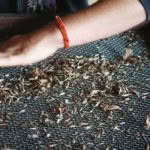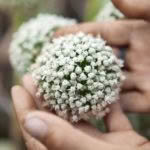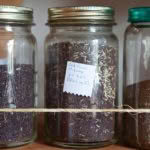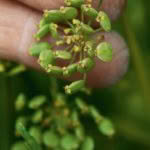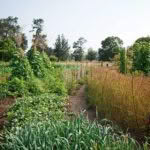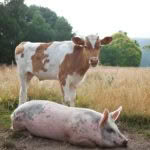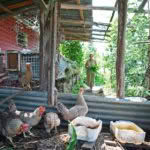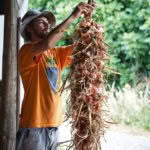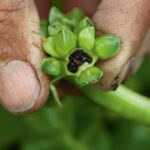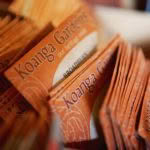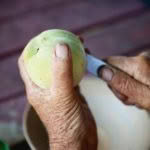A couple’s decades-long mission to save New Zealand’s heritage seeds and fruit trees at the Koanga Institute
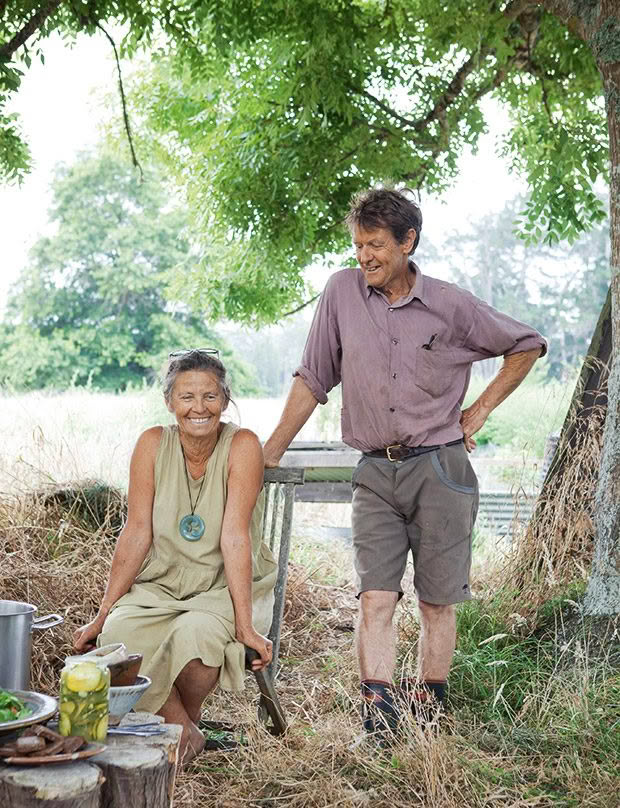
Kay Baxter and Bob Corker.
Kay Baxter and her family faced the biggest challenge of their lives in their quest to save New Zealand’s heritage seeds and fruit trees.
Words: Nadene Hall Photos: Tessa Chrisp
This story was originally published in the May/June 2015 issue of NZ Life & Leisure.
You won’t find anyone in Kotare Village who doesn’t have brown hands. It’s not because they’re out in the sun all day or that they don’t wash their hands thoroughly, but because the human-soil connection is the most important factor in growing organic vegetables and fruit, fodder trees and pasture, seeds and tubers and it’s stained into their skin at a cellular level.
The village is home to the Koanga Institute, founded by organic and permaculture gardening guru Kay Baxter. Her life for the past 30 years has been dedicated to developing a precious collection of heritage seeds and fruit trees, first in Northland, then on leased land near Wairoa. But just over a year ago Kay, her husband Bob Corker and their team faced the biggest challenge of their lives: eviction.
The development company that owned the land was foundering, the first mortgage holder was demanding a sale and everything they’d ever worked for was suddenly facing the auctioneer’s hammer.
“It’s been a really, really big journey holding the seeds for such a long time and the thought of starting again was too much,” says Kay. Supporters like chef Peta Mathias got behind what would eventually be a successful nationwide campaign to raise the money to purchase the first mortgage on the property, although there’s still more financing required and a campaign to raise that money is now underway (kotarevillage.org.nz).
Kotare Village is growing in an isolated spot about an hour’s drive south of Gisborne. Blink and you’ll miss the turn-off to the dirt track – road is too formal a word – that winds its way alongside the Mangapoike River and into a meso-climate that is home to the self-made family of gardeners and farmers who look after 800 types of seed and 100 fruit trees that form the heart of the Koanga Institute’s collection.
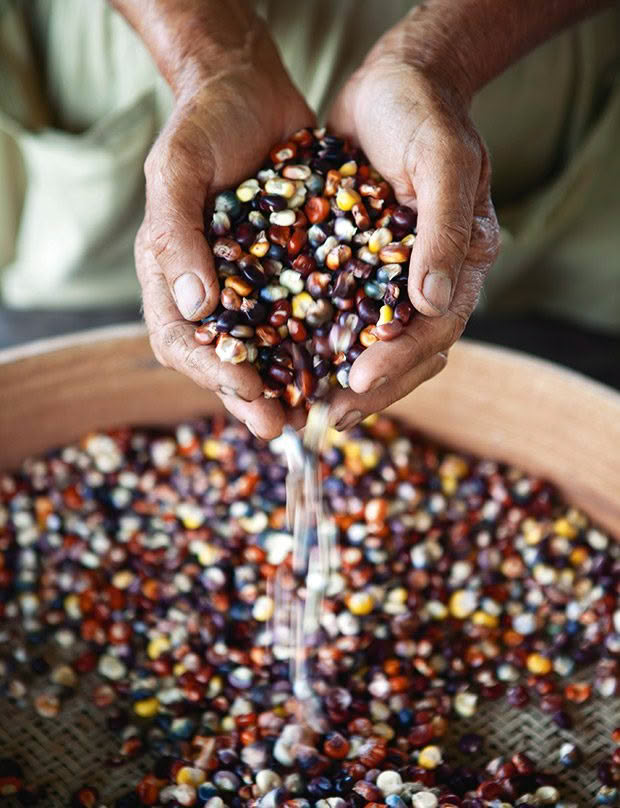
Visitors from around the world come here to learn about permaculture design, how to grow the most nutritious food possible, and the importance of living simply in this lush, green valley. “If we don’t value these seeds enough we’re going to lose them and we need them for our future; there’s heaps of science there now to show we need them,” says Kay.
“It’s not just the genetic material, the seeds and the food plants, it’s also all the models of how to grow them in a way that regenerates our own health and that of the soil, seeds and food plants.”
The 90 hectares of land are about to be placed in a community land trust, a legal framework set up to protect them, the seeds and trees and the fresh water supply that feeds them. Within it is Thorny Croft, Kay and Bob’s five-hectare slice of paradise where they will make their contributions to help supply the village with organic Dexter cattle (meat, milk), Wiltshire sheep (meat) and East Friesian sheep (milk).
Until recently they shared it with their son Taiamai, daughter-in-law Franzi and their children, but Taiamai is now doing a butchery apprenticeship so he and his family have temporarily moved south to Waipawa. His training is part of the bigger plan for Kotare where he will return to be the processor of the meat grown there.
Meat is an important part of their diet which is based on the studies of United States dentist Weston A. Price. Price spent years studying the health of indigenous tribes worldwide who were still eating their traditional diets. He found they were healthier and ingesting many more minerals and vitamins than people living in Western countries.
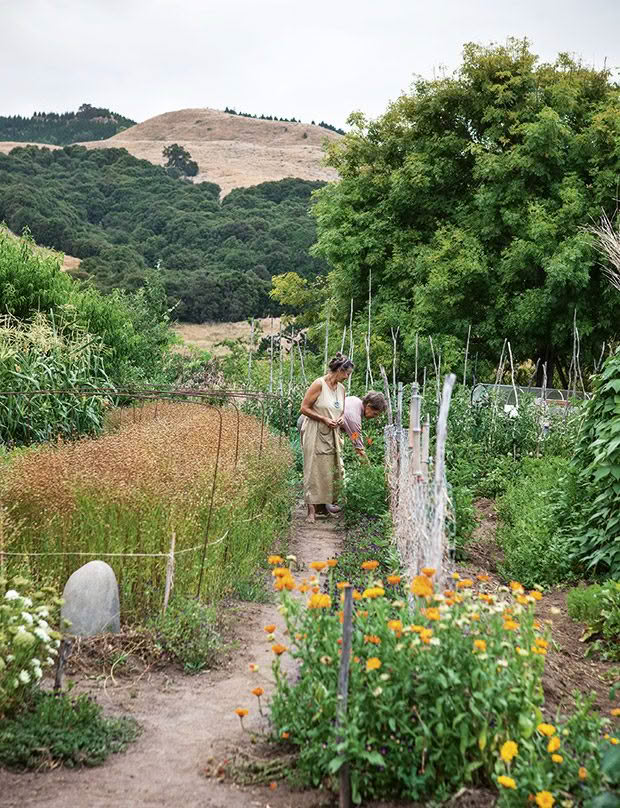
Kay and Bob in the garden where the majority of the heritage seeds are grown each year.
“We have to have clean food that hasn’t been denatured with fillers and emulsifiers,” says Kay. “We need nutrient-dense food. The industrial process just denatures it, we get unclear messages, mixed messages, weak messages going to our junk DNA which then places weak tags on our DNA so we get sick and the next generation gets sicker.
“We now know that environment determines genetic expression. Essentially, you cannot get the nourishment you need from the foods in the supermarket because it’s not nutrient dense and it’s not nutrient dense for two reasons: one is the way it’s grown and the other is the genetics that the food was grown from.”
Organic, heritage vegetables, grains and fruit, and meat, organs and bones from animals grown on highly mineralized soils full of microbial life are the best foods you can eat, and the science backs this, says Kay.
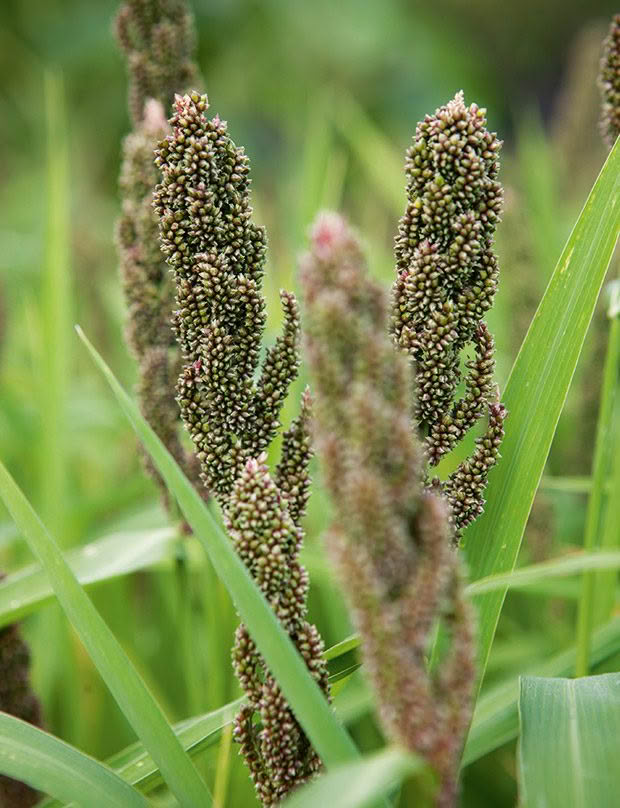
Heritage Barnyard millet is grown as a carbon crop and for eating, used as a replacement for rice.
“There’s around 20 times the nourishment in a heritage tomato than an industrial one, just from the different genetics. In apples it’s eight times, so we know we need heritage seeds and we need to grow the food in a biological system so the soil is mineralized and microbially active and those two things are key for our health and our survival.”
Bob and Kay have decided to put their ideas on food self-sufficiency to the test for the next year, taking a vow not to buy anything edible from outside the village except when they are travelling. Not that they bought a lot to begin with, says Bob. Their shopping list was always quite short: coconut oil or coconut flour, almond or other nut flours, peanut butter, maple syrup, chocolate, ice cream, salt, olive oil and mussels.
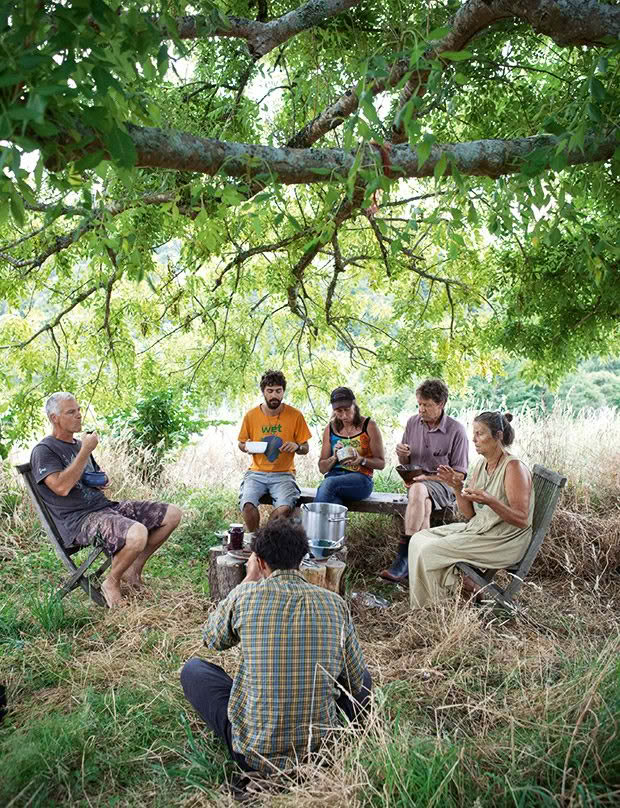
Lunch is always a community event for the gardeners and farmers at Koanga.
Flour and sugar were never on the list. The couple has used cornflour made from Koanga’s corn varieties like Blue Aztec, Pink Hopi and Manaia for many years. “We don’t use wheat flour anymore, full stop,” says Bob. “We do use some grains but we tend to eat them as whole grains so we’ll soak them and cook them, barley in particular.”
Home-grown honey is added to cooking for sweetness and they also grow the herb stevia. “It’s sweeter than the same weight of sugar. When our granddaughter Elanor comes into the garden she usually heads for the stevia first and picks a bit.” Sea salt is the one key ingredient they still buy for table use and fermentation.
- Physical isolation is important for the seed garden so the plants are not contaminated by spraying or accidental cross-pollination.
- Koanga gardeners use Niwashi hand tools for easy weed-pulling.
- The heritage livestock Bob and Kay run on their block of land include cattle, sheep, pigs, goats, geese and ducks.
- The Legbar breed is an important dual-purpose chicken.
- Caleb Gruber hangs flowering shallots to dry.
“When you first start thinking about growing all your own food, you immediately think of all the things you couldn’t give up or how difficult it all seems,” says Bob. “But once you work through the reality and become more confident it turns out it’s no big drama.”
When you grow almost 1000 food plants and trees most people assume you’re vegetarian, but meat and animal products like liver and bone have been proven by the Weston A. Price diet to be vitally important for nutrition. Kay and Bob will often cook up a broth using bones they save from meals throughout the week to create a meaty-tasting, meat-less, stock-like broth.
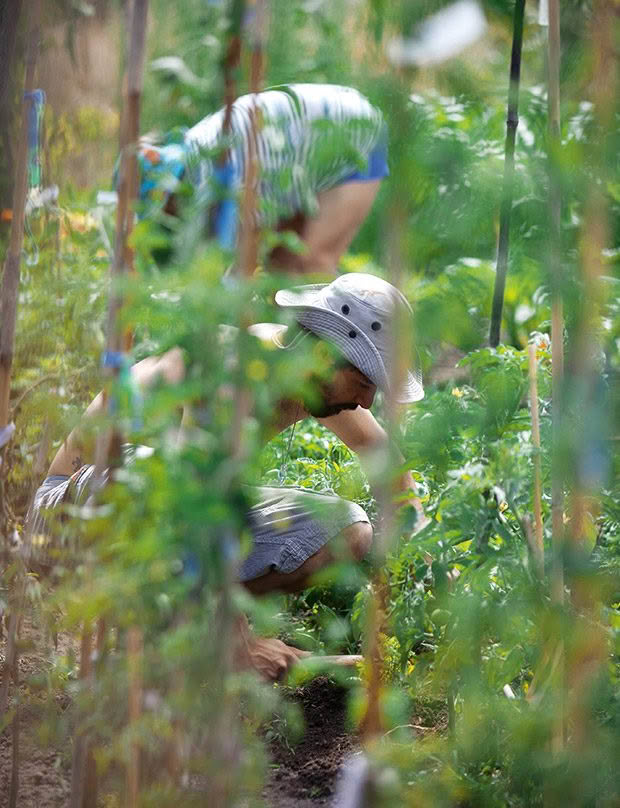
The seeds produced by Koanga staff are hand-picked then processed by hand. The best of the best are kept to become the mother plants for the following year while the best of the rest are sold to New Zealand gardeners who want the old heritage crops.
“You’re picking up a lot of calcium and minerals that are coming out of the bones,” says Bob. “You’re also picking up a lot of the gelatinous substances that are in the joints and they’re really good for our joints.”
The couple often enjoys bacon from their home-grown pigs and eggs from the Legbar hens they’ve bred over many decades to be the ultimate egg-laying, meat-providing birds. They supplement this with home-made feta, kefir (fermented milk), kimchi (fermented vegetables), sauerkraut, bottled vegetables and salads.
It is a lot of work to make sure there is something long-lasting, nutritious and tasty to eat every day. There’s a temptation to do it the easy way, by earning money and paying for someone else to do it, but Bob says the key to being self-sufficient is to decrease your need for money and there’s one easy way to do that. “It’s mainly about staying home! If you go out your wallet comes out of your pocket.”
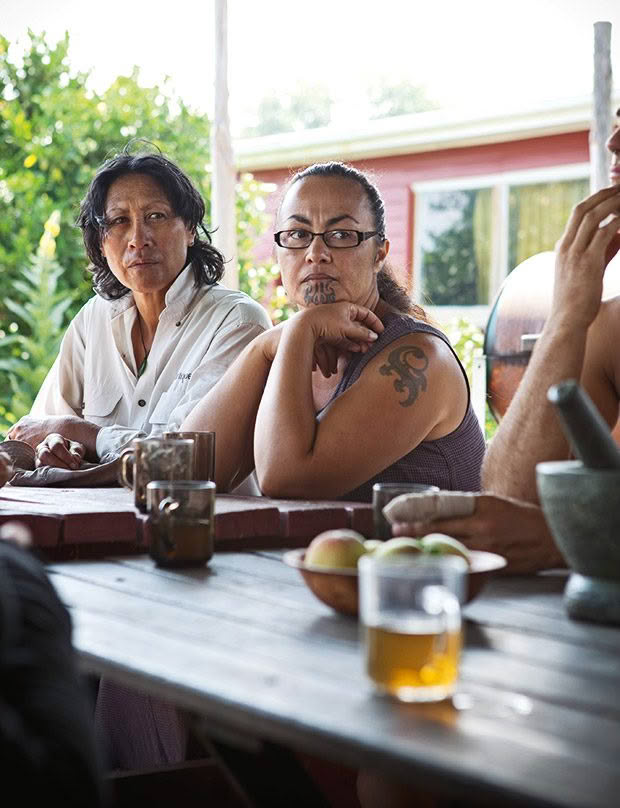
Ngaio Te Rito and Katarena Smith at the community lunch table.
That makes it difficult for a lot of people but it’s easy to make meaningful changes, says Bob. “Not everyone wants to be self-sufficient but everyone can become involved in buying local, nutrient-dense food.”
That brings us back to the seeds. Kay says their biggest lesson over 30 years of collecting and caring for them is that people and seeds must live together, as they did before big business became involved in food production.
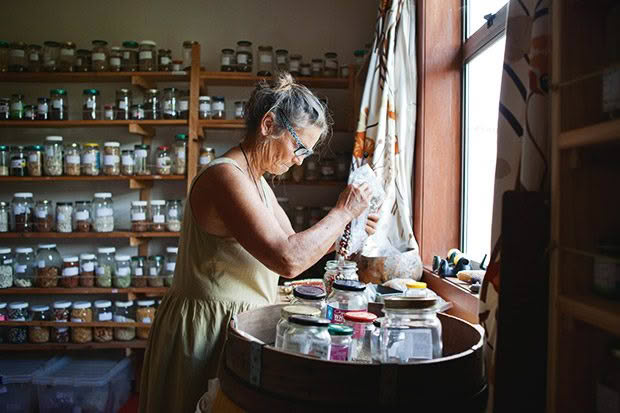
In the gloom of a quiet bedroom in the main Koanga homestead is a room full of treasures that money cannot buy – 800 different types of seed that make up the heritage collection sitting in jars, all passed on to Kay by the old gardeners.
“We need each other. In the industrial world we’ve become separated from them and we’ve come to the realization that they won’t be saved unless we use them in our lives again. The seeds belong in communities, so it’s probably going to require a village of people dedicated to keeping the seeds alive.
“It has to be people who don’t really care that they’re not dependent on having a normal salary or working hours and the only way you can do that is by living simply and gifting your time to a certain extent. It feels really important that we step back into the process of co-evolution with mother earth and our seeds. We believe that is the journey forward.”
IT’S NOT YOUR DNA, IT’S WHAT YOU FEED IT
Not everything is written in your DNA. Along the length of the double helix that makes you are chemical markers and switches known as junk DNA that can turn on – or off – the expression of a gene.
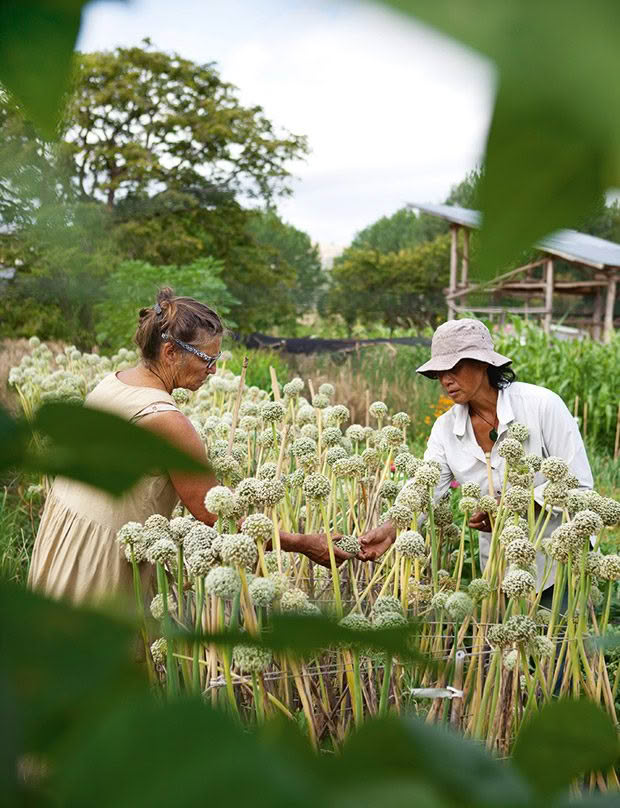
Kay and Ngaio Te Rito check the Pukekohe Long Keeper onion crop in the main seed garden.
You might have a gene that predisposes you to diabetes, but whether that gene turns on is affected by what your parents ate or breathed or suffered (stress, for example) during their lives before you were conceived, and even further back to the lives of your grandparents and great-grandparents.
Scientists have used diet alone to extend the lifespans and vastly improve the health of mice genetically predisposed to cancer and diabetes through a dodgy gene (known as the agouti gene) just by changing the diets of the mother mice. They were fed onions, garlic and beets, all high in methyl donors. Those chemicals affected the development of the embryos as they grew, attaching to chromosomes and dialling down the effect of the agouti gene. They lived long, healthy lives compared to the short, diseased lives of their parents.
- The Long Green Bush Marrow is as big as a muscly arm, lasts for ages and is far tastier than any courgette.
- A Mamie Ross peach, green skinned, white fleshed, super juicy, melt-in-the-mouth and rescued from an original tree that’s now more than 100 years old.
- Koanga has saved almost 60 types of heritage tomato from the yellow, acid-free, egg-shaped J Walsh to Sweet William, a tiny super-sweet dwarf.
- The heritage collection includes two types of raspberry.
This new science, known as epigenetics, confirms what Kay has suspected all along: that nutrient-dense food makes you healthier and also has a big impact on the health of your children, your grandchildren and their children.
WHY NEW ZEALAND’S HERITAGE SEED COLLECTION STARTED WITH A NUCLEAR BANG
Kay Baxter has never travelled to Chernobyl but the nuclear explosion there changed her life and began her quest to collect and save heritage seeds.
“We had friends in Holland whose farm had been covered in nuclear fallout and it was happening all through Europe, but particularly in Holland, and they’d had to bulldoze all the topsoil off their farm so they could continue farming there. It was horrific.”
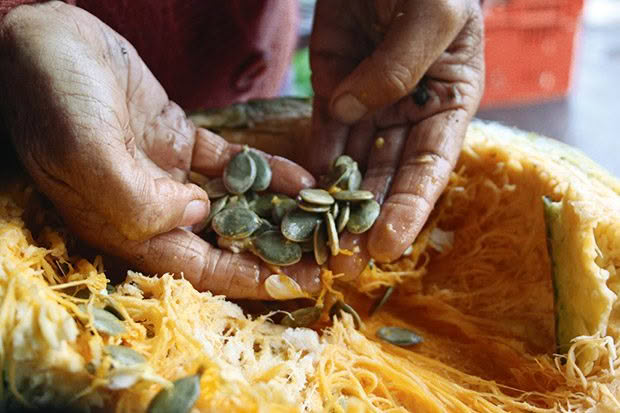
But it was also half a world away so Kay didn’t think it could impact New Zealand until a couple of months later when she accidentally fell into conversation with a stall-holder at Fieldays.
“He said did I know that the only New Zealand seeds we could buy were Pukekohe Long Keeper onions and all the rest came from Holland? And here we were in this country and no one knew, no one had a clue, and I just walked out of there knowing I was going to do something. I’d never heard of heritage seeds; I’d never heard of seed saving.”
Kay decided to join the local garden club and on her first visit a woman gifted her a bag of heritage bean seeds. “I realized the old seeds had to be with the gardeners, so I started looking there. We had heaps of TV coverage and Julian Matthews did a story years and years ago when he was the editor of New Zealand Gardener and I got 500 letters – it was just unheard of.
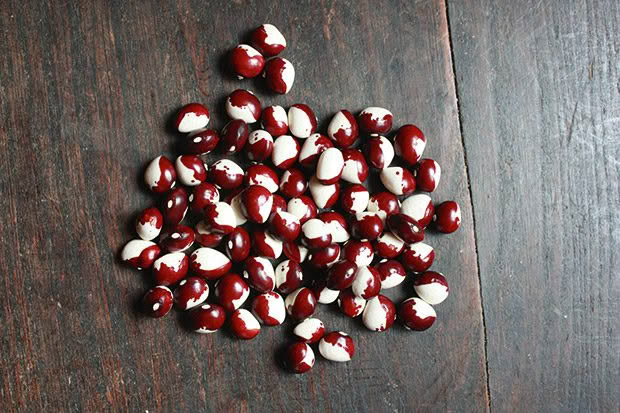
“The food plants and the seeds touch people somehow. We’ve got between one and five percent of the seeds we had 100 years ago. Someone has to keep them alive or that’s it, and it’s really clear now that industrial food isn’t going to maintain our health through the generations, so heritage seeds are totally key to our future.”
The Koanga Institute heritage seed collection now numbers more than 800. It’s available at selected garden centres nationwide and online at koanga.org.nz
Love this story? Subscribe now!
 This article first appeared in NZ Life & Leisure Magazine.
This article first appeared in NZ Life & Leisure Magazine.
